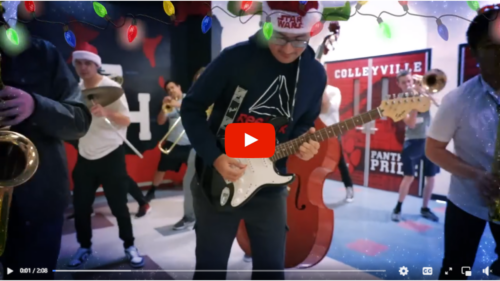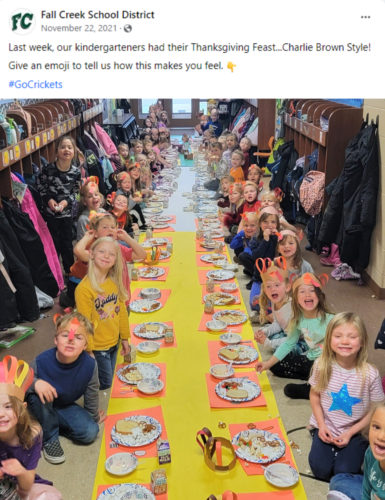If you’re anything like me, you love a good list.
When work or life feels especially overwhelming, it’s so helpful to break things down into a quick to-do checklist! I feel the same way when tackling a complicated process or learning how to do something new. There’s something comforting about working your way through a set of rules and steps.
And yet, when it comes to the always-evolving world of social media, we sometimes need to throw the rulebook out the window!!
Now, I’m not suggesting anything crazy. Some school social media guidelines are ALWAYS going to be best practices, like making sure your content is 75% celebratory and 25% informational and using one email address to collect content and keep your sanity.
Still, I’m comfortable with bending the rules in other areas. Here are six social media rules you could consider breaking and why (including examples!)
Rule #1: Your Profile Photo is Always Your Logo
When it comes to your school’s social media profiles, I encourage you to maintain consistent branding across your platforms. That way, your followers will instantly recognize that these accounts are the official school communication channels.
This means having standard logos and specified logo variations and using a high-resolution, circular version of your logo as your social media profile picture. Make sure it isn’t cut off when you view it on desktop and mobile, and choose a logo version without words, if possible.
But sometimes… you can break this rule.
Do you have a special campaign going on, such as a bond or referendum? Consider changing your logo to something that reinforces this campaign.


Is your logo a mascot? Could you change this out to match the seasons, like adding a winter hat to your eagle during the colder months? Certainly not necessary – but it could be fun! Here are some examples of how Peel District School Board has changed its Facebook profile images for different occasions and seasons.
Remember, if you decide to have seasonal or temporary logos for special campaigns, keep it consistent across all your official channels. And set a reminder on your calendar to switch it back!
Sign up here!
Rule #2: Post Only on Weekdays
I generally recommend skipping weekend social media posts for two reasons:
- There tends to be less engagement on weekend posts.
- Social media managers deserve a break, too!
It’s not unreasonable for you, as a school social media manager, to have some time off from monitoring comments and checking to make sure your scheduled posts went up as planned. Work-life harmony is SO important for preventing burnout in your role!
Yet, it could make sense to break this rule on certain occasions.
Perhaps a big event is happening over the weekend, like a playoff game, high school dance, or state forensics meet. You can definitely feel empowered to just wait until Monday, but if you have the time, take a few moments to put up a celebratory post. You can keep it short and sweet with a simple photo/video and caption – “Congrats to our ___ team for ____ – more photos to come!”
Here’s an even better idea: Work with a student contributor or organize a student takeover ahead of time so that the content goes up without your immediate involvement! Here are some tips and tricks for facilitating a successful takeover:
Some school districts also receive tons of content, so during those extra-busy weeks, you might have some spillover posts that get published over the weekend.
Rule #3: Post a Minimum of 10x Per Week When School is in Session
I’ve been doing this for years and years, and the stats don’t lie: Schools that consistently post a minimum of 10 times every week (that’s 2 posts per weekday) see the best engagement and growth. This is a great minimum standard to set for your channels, and if you’re finding it easy to get enough content to meet this, go ahead and set your sights even higher!
Social media features are one way to keep this posting frequency, by the way:
(Note: During school breaks, I still advise posting at least 3-5 times per week so your engagement doesn’t tank and the algorithm still recognizes your content as worthwhile.)
But there are definitely occasions when it makes sense to pull back or even “go dark” on your school’s social media channels. If your school or community experiences a tragedy or credible safety threat, continuing with your celebratory content could appear insensitive.
Make sure you communicate directly with families about the tragedy or crisis because not everything belongs on social media, and stop posting normal content for a period of time. Here are some more helpful tips on this topic:
Rule #4: Skip General Holiday Posts
Let’s face it: No one is waiting on their local school district to wish them a “Happy Labor Day” or “Happy Independence Day.” Sure, those could be nice filler posts, and I’m not saying it’s wrong to post them. But I’m willing to bet those generic holiday posts don’t get much engagement!
Instead, break that rule by being more intentional with your content. Celebrate holidays that are meaningful to your school community by sharing student stories, events, craft projects from classrooms, holiday party photos, and more. Those stories about students and staff will reach and engage MANY more people than just a generic graphic!
Here are some examples! Click on each photo below to be taken directly to the Facebook post.
Rule #5: Videos Should be Under 1 Minute
As a general rule, social media videos should be short and captivating. With Instagram Reels and TikTok being so wildly popular, audiences quickly skip past videos that are too long or don’t capture immediate attention. Videos should never be any longer than they have to be to convey the message!
But you can break this 1-minute rule if you have truly engaging content. Perhaps you have an emotional story to tell, or you’re producing an action-packed enrollment promotion. Longer videos can certainly work on social media; just keep an eye on your social media analytics to see which videos get more views, likes, comments, and shares, then adjust your future videos accordingly.
Here are some examples!
Mountain View Whisman School District – Staff Housing Video

Monroe Local Schools – National Bus Driver Appreciation Day 2023 Video

Grapevine-Colleyville ISD – Rockin Around GCISD Video

Bellingham Public Schools – The Bellingham Promise Awards 2022 Video

Rule #6: Never Turn Off Comments
Social media should be social – and that means allowing people to comment on your content. I believe that comments are an important part of effective school social media. Blocking all comments will severely reduce your ability to engage your community with all the wonderful things happening in your district!
However, sometimes, limiting or turning off comments on a particular post or even across your entire account is necessary. You should always connect with your legal counsel before turning off comments. Here are some times that you could consider taking this step:
- What if your school goes viral for a post or incident, and the comments come in from all over the world? If a post on your page has reached more than one million people and you are concerned about the safety and well-being of your students, staff, or community, you may need to turn comments off on the page or post. We have even seen some schools temporarily deactivate their page.
- When you post a general “Crisis Update,” it should include pointing your followers to the appropriate spot to get answers to their questions. One school communicator shared he had turned off comments after the district posted a statement on social media about a situation. They wanted the information out to the general public but wanted to avoid the criticisms and questions their district couldn’t (or wouldn’t) answer.
- Weather updates can bring out the peanut gallery! Some schools have decided to post those and then turn off comments so they don’t have to spend all their time monitoring the sarcasm or criticism while trying to get the word out on multiple channels.
- You can shut off comments when it will help protect a student or staff member.
- Are you announcing a big change, like a bus company or superintendent personnel change? Many people may question or voice their opinion when you’re really just trying to get the word out. I often say not everything needs to be posted on social media (read this blog for a helpful guide), but if you decide to do it, you may turn off the comments. If you go this route, provide instructions on who your followers can contact if they have additional concerns.
- Sometimes, it is just a perfect storm. A heated school board election, controversial policies, national news attention, and/or extremely polarized factions within the school district. If your comments section is taken over by arguing and random people from outside your district or even your state, you may want to limit the ability to comment temporarily.
How to Limit Commenting on Social Media
Years ago, we didn’t have as many options for limiting comments on social media, but today, many platforms have a range of settings you can tap into. Depending on the platform, your options could include:
- Shutting off comments on a post-by-post basis
- Limiting the ability for people to tag or mention your page
- Turning off direct messaging
- Uploading a “banned word” list
- Using Moderation Assist to hide comments automatically
Learn how to use Facebook’s incredibly helpful Moderation Assist tool in this blog:
And remember, your communication toolbox as a School PR professional includes much more than just social media! Download this free guide to help inspire your creativity:
So, are you feeling empowered to be a bit of a rule-breaker!? Which of these rules do you feel comfortable breaking for your school’s social media? Let me know in the comments!














